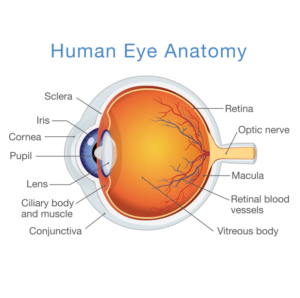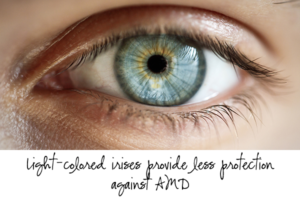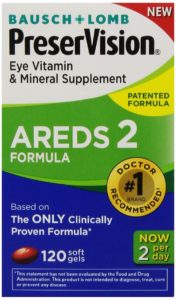Dear FOFriends: Bausch + Lomb has compensated FabOverFifty for this blog. I assure you that the content is factual and valuable, and all opinions are my own! – Geri Brin
If you’re at least 50 years old, please stop for a moment and do this:
Cover your right eye with your hand (if you wear glasses, you can keep them on), then make a fist with your left hand, and put it over your left eye. Notice how the central vision is cut off in your left eye? That’s what happens if you get advanced Age-Related Macular Degeneration (AMD), a leading cause of vision loss in Americans age 50 and older, according to the National Eye Institute.

![]() AMD will impact over 11.5 million Americans, and 9 million will experience moderate to advanced AMD, reported the American Medical Association. One in five people over the age of 65 will be diagnosed with AMD, according to the American Foundation for the Blind.
AMD will impact over 11.5 million Americans, and 9 million will experience moderate to advanced AMD, reported the American Medical Association. One in five people over the age of 65 will be diagnosed with AMD, according to the American Foundation for the Blind.
 “We all take our vision for granted on some level, until something happens,” said Dr. Michael Cooney, a New York City- based ophthalmologist and retina specialist who focuses on the treatment of eye diseases, particularly AMD and diabetic retinopathy. AMD affects more Americans than Alzheimer’s Disease, according to the Alzheimer’s Association. “Early-stage AMD often does not present any symptoms or changes in vision,” Dr. Cooney explained. “Something can be going wrong with an eye, and you won’t even know it because the other eye compensates, and your brain can fill in the blanks,” he cautioned.
“We all take our vision for granted on some level, until something happens,” said Dr. Michael Cooney, a New York City- based ophthalmologist and retina specialist who focuses on the treatment of eye diseases, particularly AMD and diabetic retinopathy. AMD affects more Americans than Alzheimer’s Disease, according to the Alzheimer’s Association. “Early-stage AMD often does not present any symptoms or changes in vision,” Dr. Cooney explained. “Something can be going wrong with an eye, and you won’t even know it because the other eye compensates, and your brain can fill in the blanks,” he cautioned.
This explains why experts like Dr. Cooney recommend a comprehensive dilated eye exam once a year for people over the age of 50, which will screen for a “whole host of vision-threatening problems, particularly AMD.” And what better time to request your annual eye exam than now, during AMD Awareness Month. During February, Bausch + Lomb, a Valeant Pharmaceuticals International, Inc. company whose mission is to protect, enhance and restore people’s eyesight, encourages you to put your eyesight first and understand the risk factors of AMD, to help reduce the risk of progression.
“We pay more attention to our knees than to our eyes,” Dr. Cooney added. “I’m a retina specialist, and I still take my vision for granted. But if you lost your eyesight, your life would change dramatically.” To help us fully appreciate his advice, FabOverFifty asked Dr. Conney to give us a basic lesson on AMD.
HOW DOES AMD AFFECT THE EYES?
“AMD affects your retina, which is the part of your eye that’s like the film of a camera. The macula, at the center of the retina, processes sharp, clear, straight-ahead vision for recognizing faces, reading, watching TV, and driving.
“AMD starts with little drusen, which are yellow deposits made up of fatty proteins that accumulate in your macula. These aging changes are sort of like wrinkles or gray hairs. You’d have no idea that you have drusen because early-stage AMD often doesn’t present any symptoms or vision changes. It’s like high blood pressure, which you generally don’t feel, and don’t know you have, unless a doctor measures it and tells you.”
WHEN DOES AMD AFFECT THE VISION?
 “The first stage of AMD is known as dry macular degeneration, which can weaken the retina and convert to the wet type, where little blood vessels grow, like weeds that want to take over a garden. These blood vessels leak fluid and create scar tissue in the macula that can cause a very abrupt and rapid loss of straight-ahead vision over weeks to months.
“The first stage of AMD is known as dry macular degeneration, which can weaken the retina and convert to the wet type, where little blood vessels grow, like weeds that want to take over a garden. These blood vessels leak fluid and create scar tissue in the macula that can cause a very abrupt and rapid loss of straight-ahead vision over weeks to months.
“The layer of blood vessels underneath your retina is called the choroid, which has the highest level of circulation of any tissue in your body, and requires a high metabolic activity of oxygen and nutrients to keep that area healthy and functioning. The high cell turnover in this area increases the proclivity for macular degeneration.”
WHAT PERCENT OF THOSE WITH DRY MACULAR DEGENERATION DEVELOP THE WET TYPE?
“Ten percent.”
WHO IS AT GREATEST RISK FOR DEVELOPING AMD?
 “I like to break the risk factors into two groups. Those you can’t change and those that can be modified. The factors in the first group include: Age (the older you are, the more likely you are to develop AMD); Sex (women are at greater risk, although we don’t know why); Ethnicity (Caucasians have a higher incidence); Eye Pigment (Light-colored irises provide less protection against AMD), and Genetics (80 percent of your risk is in your genes. If even one of your parents had wet macular degeneration, your disposition is higher.)
“I like to break the risk factors into two groups. Those you can’t change and those that can be modified. The factors in the first group include: Age (the older you are, the more likely you are to develop AMD); Sex (women are at greater risk, although we don’t know why); Ethnicity (Caucasians have a higher incidence); Eye Pigment (Light-colored irises provide less protection against AMD), and Genetics (80 percent of your risk is in your genes. If even one of your parents had wet macular degeneration, your disposition is higher.)
“Modifiable risk factors are the same as for heart disease, which include: High Blood Pressure And Cholesterol; Excess Weight, Lack of Exercise, Poor Nutrition, and Cigarette Smoking. It’s important to eat a healthy diet that includes green leafy vegetables and fatty fish, to exercise regularly and to maintain normal blood pressure and cholesterol.”
CAN ANY TREATMENTS STOP THE PROGRESSION OF AMD?
“A landmark age-related eye disease study (AREDS) in the 1990s, performed by the National Eye Institute (part of the National Institutes of Health), set out to determine if various vitamins and nutrients could 1.) help slow down the progression of AMD and 2.) actually decrease the rate of vision loss over the next five years of people diagnosed with intermediate AMD.
 “After five years of an AREDS 1 trial, scientists found that a certain formula, consisting of antioxidants and zinc, had a statistically significant benefit on both the progression of AMD and on vision loss for those with moderate to advanced AMD.
“After five years of an AREDS 1 trial, scientists found that a certain formula, consisting of antioxidants and zinc, had a statistically significant benefit on both the progression of AMD and on vision loss for those with moderate to advanced AMD.
“An AREDS 2 trial in 2013 recommended an improved AREDS 2 formula that included the protective nutrients lutein and zeaxanthin. These are found in the macula when we’re born, but decrease and are no longer made by our bodies as we age. Since it’s difficult to get the levels of the beneficial nutrients from diet alone, or with a multivitamin, the AREDS 2 formula eye vitamins have become the standard therapy for those with moderate to advanced AMD.”
NOTE FROM FABOVERFIFTY: PreserVision AREDS 2 Formula eye vitamin, developed by Bausch + Lomb, is the #1 doctor-recommended brand for treating moderate to advanced AMD.
ISN’T THERE A TEST YOU CAN DO AT HOME TO TELL IF YOU HAVE AMD?
“The Amsler Grid can help you self-monitor your straight-ahead vision, and can indicate that something might be going on inside your eyes. It’s not a perfect test, however, and not meant to replace a comprehensive dilated eye exam.”![]()
WHAT KIND OF DOCTOR SHOULD WE SEE FOR THE COMPREHENSIVE EYE EXAM?
“An ophthalmologist is the best person to go to; if you’re diagnosed with AMD, you should see a retina specialist.”
CAN ADVANCED AMD CAUSE BLINDNESS?
“Even if you have the worst case of AMD in the world, you will have lost 5 percent of your vision, but the other 95 percent, your peripheral vision, won’t be affected. You will not go pitch-black blind from AMD.
IS POOR EYESIGHT CONNECTED TO AMD?
“There is no connection between the two.”
CAN THE RETINA BE REPLACED?
“We can do cornea transplants, but not retina transplants.”


0 Responses to “20% Of Us Who Are Over 65 Will Get This Disease”
Janet LaMere says:
Can I start taking AREDS2 now to help ward off AMD? I have many risk factors, including the fact that my father had both wet and dry macular degeneration, one type in each eye.